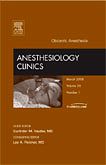Obstetric Anesthesia, An Issue of Anesthesiology Clinics, 1st Edition
Author :
Gurinder Vasdev
For an anesthesiologist, though the challenge of managing an obstetric patient can be very satisfying and rewarding, it can also be extremely difficult given the potential for serious harm to the fetus and mother. For routine care, it is important t
...view more
For an anesthesiologist, though the challenge of managing an obstetric patient can be very satisfying and rewarding, it can also be extremely difficult given the potential for serious harm to the fetus and mother. For routine care, it is important to understand the risks and benefits of many practices to provide patients with informed decisions and the most satisfying experiences. There are also many less-usual patients and situations, however, that challenge the anesthesiologist’s skills significantly. This issue of the Anesthesiology Clinics presents the most up-to-date information on both of these categories, and is written by an outstanding group of experienced clinicians from all over the world. Topics including high-risk analysis, use of simulators for training, major hemorrhage, off-labor-floor consultation, depth of anesthesia monitoring, pharmaceuticals, use of vasopressors, neurological infections after neuroaxial anesthesia, airway management, the HIV patient, ultrasound, and others.
Your discount code here : #FB456
For an anesthesiologist, though the challenge of managing an obstetric patient can be very satisfying and rewarding, it can also be extremely difficult given the potential for serious harm to the fetus and mother. For routine care, it is important to understand the risks and benefits of many practices to provide patients with informed decisions and the most satisfying experiences. There are also many less-usual patients and situations, however, that challenge the anesthesiologist’s skills significantly. This issue of the Anesthesiology Clinics presents the most up-to-date information on both of these categories, and is written by an outstanding group of experienced clinicians from all over the world. Topics including high-risk analysis, use of simulators for training, major hemorrhage, off-labor-floor consultation, depth of anesthesia monitoring, pharmaceuticals, use of vasopressors, neurological infections after neuroaxial anesthesia, airway management, the HIV patient, ultrasound, and others.
Author Information
By Gurinder Vasdev
| ISBN Number | 9781416060628 |
|---|---|
| Main Author | By Gurinder Vasdev |
| Copyright Year | 2008 |
| Edition Number | 1 |
| Format | Book |
| Trim | Other |
| Imprint | Saunders |
| Page Count | 240 |
| Publication Date | 25 Mar 2008 |
| Stock Status | IN STOCK - This may take up to 5 business days to ship |
Write Your Own Review
Only registered users can write reviews. Please sign in or create an account
product
https://www.us.elsevierhealth.com/obstetric-anesthesia-an-issue-of-anesthesiology-clinics-9781416060628.html
5859
Obstetric Anesthesia, An Issue of Anesthesiology Clinics
https://www.us.elsevierhealth.com/media/catalog/product/9/7/9781416060628.jpg
69.29
98.99
USD
InStock
/Medicine/Anesthesiology
/Clinics
/Clinics
30
4388725
5255041
1
3
8
4182692
5145120
For an anesthesiologist, though the challenge of managing an obstetric patient can be very satisfying and rewarding, it can also be extremely difficult given the potential for serious harm to the fetus and mother. For routine care, it is important to understand the risks and benefits of many practices to provide patients with informed decisions and the most satisfying experiences. There are also many less-usual patients and situations, however, that challenge the anesthesiologist’s skills significantly. This issue of the Anesthesiology Clinics presents the most up-to-date information on both of these categories, and is written by an outstanding group of experienced clinicians from all over the world. Topics including high-risk analysis, use of simulators for training, major hemorrhage, off-labor-floor consultation, depth of anesthesia monitoring, pharmaceuticals, use of vasopressors, neurological infections after neuroaxial anesthesia, airway management, the HIV patient, ultrasound, and others. For an anesthesiologist, though the challenge of managing an obstetric patient can be very satisfying and rewarding, it can also be extremely difficult given the potential for serious harm to the fetus and mother. For routine care, it is important to understand the risks and benefits of many practices to provide patients with informed decisions and the most satisfying experiences. There are also many less-usual patients and situations, however, that challenge the anesthesiologist’s skills significantly. This issue of the Anesthesiology Clinics presents the most up-to-date information on both of these categories, and is written by an outstanding group of experienced clinicians from all over the world. Topics including high-risk analysis, use of simulators for training, major hemorrhage, off-labor-floor consultation, depth of anesthesia monitoring, pharmaceuticals, use of vasopressors, neurological infections after neuroaxial anesthesia, airway management, the HIV patient, ultrasound, and others.
0
0
add-to-cart
9781416060628
2011 and earlier
Professional
By Gurinder Vasdev
2008
1
Book
Other
Saunders
240
Mar 25, 2008
IN STOCK - This may take up to 5 business days to ship
By <STRONG>Gurinder Vasdev</STRONG>
Clinics
Clinics
The Clinics: Surgery
No
No
No
No
Please Select
Please Select
Please Select
Related Products
-
35% OFF
 Online Resource
Netter's Dissection Video Modules (Retail Access Card)
Online Resource
Netter's Dissection Video Modules (Retail Access Card)University of North Carolina Chapel Hill and Frank H. Netter
Oct 2015
Special Price $117.64 $180.99 -
30% OFF
 Book
Nolte's The Human Brain in Photographs and Diagrams
Book
Nolte's The Human Brain in Photographs and DiagramsTodd W. Vanderah
Jan 2019
Special Price $44.79 $63.99 -
35% OFF
 Book
Book
-
35% OFF
 Flash Cards
Flash Cards
-
35% OFF
 Book
Book
-
35% OFF
 Book
Book
-
30% OFF
 Book
Book
-
35% OFF
 Flash Cards
Flash Cards
-
35% OFF
 Book
Book
-
35% OFF
 Flash Cards
Flash Cards




